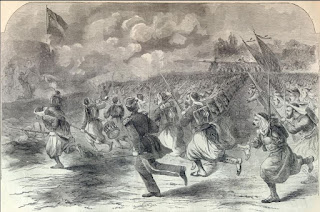 |
| 18th NC flag, NC Museum of History |
Did the Branch-Lane
brigade have the most recognizable flags in the Confederacy? Quite possibly. On
the front cover of my new book is the "Branch pattern" flag of the
18th North Carolina Infantry. It is a standard 3rd pattern Army of Northern
Virginia flag, with battle honors painted in a distinct white scalloped style. As
far as I can tell, no other ANV infantry regiment ever had such a distinctive
style flag. The flags of the 3rd, 13th and 15th South Carolina are similar, but
not enough to attribute it to the same painter. The battle honors are not as
bold.
Following the Seven
Days battles, Brig. Gen. Lawrence O'Bryan Branch was authorized to have new
battle flags inscribed with the regiments' battle honors. The quartermaster was
responsible for furnishing flags to the brigade. The flags of the 7th, 33rd,
and 37th regiments were authorized to be emblazoned "New Berne, Slash
Church, Mechanicsville, Gaines Mill, Fraziers Farm, [and] Malvern Hill."
The flags of the 18th and 28th regiments were embellished with "Slash
Church, Mechanicsville, Gaines Mill, Fraziers Farm, [and] Malvern Hill."
 |
| 37th NC flag, Museum of the Confederacy |
When the flags of the regiment were issued to the brigade in
December 1862, the battle honors had undergone some changes. Instead of
"Slash Church," the flags now had Hanover. Gaines Mill was now Cold
Harbor. Other honors were listed as well, including Cedar Run, Manassas,
Manassas Junction, Ox Hill, Shaprsburg, and Harper's Ferry.
According to the compiled service records, the flags arrived
in camp in early December 1862. Captain George S. Thompson, quartermaster for
the 28th Regiment, signed for his regiment's flag on December 4, 1862. The
statement reads "One Battle Flag with inscription." That's an
important little fact. I would take it to mean that the flags arrived in camp,
from Richmond, already painted with their battle honors. Obviously, there was
some discussion from the time that Branch requested the flags, until when they
were actually painted (after September 1862) with someone at the
Quartermaster's Department.
 |
| 28th NC flag, Museum of the Confederacy |
The brigade, now belonging to James H. Lane, carried these
flags through the battles of Fredericksburg and Chancellorsville. The 18th NC
lost its flag at Chancellorsville. Glen Dedmondt writes in his book, The Flags of Civil War North Carolina,
that A. P. Hill's division was issued new flags in June 1863. The 7th NC
obviously stuck their "Branch" flag back in a wagon. Their new flag
was captured on July 3, on the slopes of Cemetery Ridge by a member of the 1st
Delaware Infantry. The 28th North Carolina also lost a flag, but not the new
one. Their Branch flag was captured on July 3. Dedmondt believes the 33rd NC
carried its new flag through the Gettysburg campaign, until it was captured at
the Wilderness on May 6, 1864.
 |
| 33rd NC flag, Museum of the Confederacy |
So the Branch pattern flag of the 18th was captured at
Chancellorsville, and that of the 28th at Gettysburg. The 37th North Carolina's
Branch flag was captured on April 2, 1865, as the Federals overran the
breastworks below Petersburg. The 33rd North Carolina's Branch Pattern flag was
supposedly in Battery Gregg as the fighting took place. It was captured at some
point after April. So what became of the 7th's Branch pattern flag? The 7th NC had
been ordered back to North Carolina in February 1865, to try and help round up
deserters. Instead of surrendering their flag, the men cut it up, each taking a
piece of it home with him. This seems to be a common practice with Army of
Tennessee regiments.
Pieces of all three flags survive. A fragment of the 7th
NC's Branch pattern flag is at the North Carolina Museum of History, along with
the 18th NC's Branch pattern flag. The Branch pattern flags of the 28th, 33rd,
and 37th Regiments are at the Museum of the Confederacy.
 |
| 7th NC flag fragment, NC Museum of History |
Back to my original argument. I would say that the Branch
pattern flags of the Branch-Lane brigade are the most distinctive depot-issued
flags of the Army of Northern Virginia.
Thanks to Charlie Knight of the North Carolina Museum of
History for help with this post.





